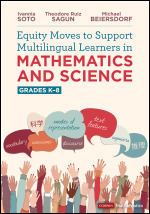Equity Moves to Support Multilingual Learners in Mathematics and Science, Grades K-8
Corwin Mathematics Series
A strengths and assets-based approach to multilingual learner success
As the number of multilingual learners (MLLs) in US schools continues to grow, educators need to learn the moves necessary to support the success of these students in mathematics and science.
Equity Moves to Support Multilingual Learners in Mathematics and Science, Grades K-8 focuses on the literacy opportunities that MLLs can achieve when language scaffolds are taught alongside rigorous math and science content. It provides a framework teachers can use to develop equity-centered, scaffolded math, science, or STEAM lessons. Readers will find
- Anchor phenomena that demonstrate issues with lesson design and delivery and highlight areas to include language and content scaffolds
- Examples for honoring the languages of students, families, and communities
- Culturally responsive techniques and easy-to-use tables featuring the equity moves
- Vignettes showcasing the equity move in the classroom setting
- A focus on four language demands: vocabulary, discourse, multiple modes of representation, and text features
With an assets-based approach to what MLLs can do, this book helps teachers unpack the language demands of mathematics and science and encourages reflection of their own practices in scaffolding for language and culture.
Free resources
Vocabulary Considerations
Learn more about math and science vocabulary considerations in this excerpt.
This powerful book reminds us of every student’s assets and cultures in the learning spaces. The intentionality of using specific language and content
scaffolds and culturally sustaining practices is essential for drawing the brilliance of multilingual learners. Educators seeking practical approaches to support multilingual learners will find clear guidance for immediate implementation.
It is so exciting to see a book for MLL instruction in K–8th that focuses on math and science! Soto’s framework connects language and content with
culturally responsive teaching. Vignettes, equity moves, and strategy descriptions provide a practical way to address math and science standards
with guiding questions to engage teachers. Sample lessons highlight the aspects of the framework.
Soto, Sagun, and Beiersdorf speak to the critical need to build on student assets while engaging in authentic learning through cultural and responsive standards-based pedagogy. The equity moves come alive with specific student examples and the research base and scaffolds needed to engage in authentic learning so multilingual learners can thrive.
Delivering math and science instruction for multilingual learners will remain elusive without this how-to book. Successful STEAM or STREAM
education hinges on reducing the language barrier to conceptual understanding for students who are linguistically different. This clearly written
book provides a blueprint for changing the learning trajectory for multilingual learners with teaching strategies that are engaging, effective, and practical for today’s diverse classrooms.
Through the inclusion of research-based instructional strategies, concrete examples, and classroom vignettes, Soto, Sagun, and Beiersdorf
demonstrate how a culturally responsive teaching lens can be naturally integrated into math and science lessons. Their equity moves are powerful
action steps that educators can take to build on MLLs’ cultural and linguistic backgrounds while fostering both content and language learning.
Equity Moves to Support Multilingual Learners in Mathematics and Science, Grades K–8 is an important work that connects research to practice in meaningful and useful ways. It is a powerful tool for all teachers of multilingual students and should be required reading in teacher preparation programs. Congratulations to the authors for this outstanding work.

